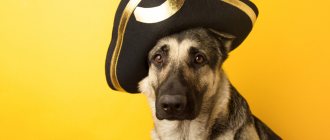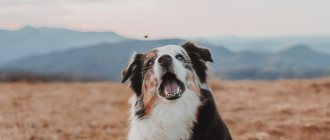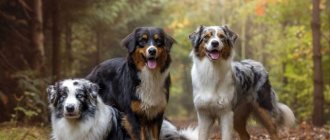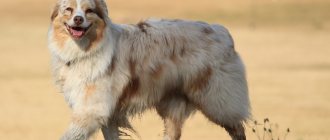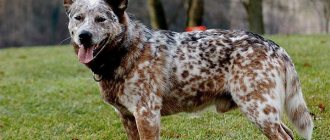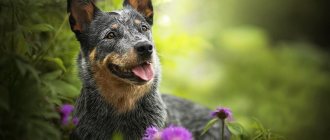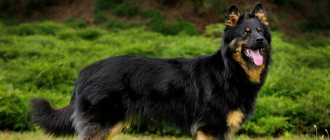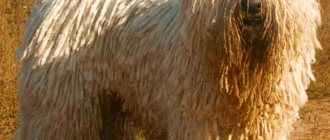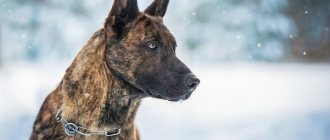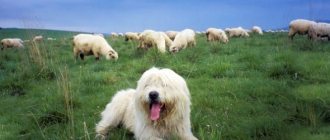The Australian Shepherd Aussie (or Ossie) is a born shepherd. It is enough just to show her what needs to be done, and the animal will happily begin to complete the task. The intelligent and hardy breed quickly spread throughout the world and is still popular. However, now Aussies are adopted as family friends. Also, Australian Shepherds perform excellently in the service of government agencies (including in searching for drugs, rescuing people) and are revered as guide dogs. Let's find out why Aussies are so loved by dog breeders.
Description of the Aussie breed
Popularity 153rd among 263 dog breeds
Lifespan:
13-15 years old
Breed group:
Shepherd's
Height:
males: 52-58 cm, females: 46-53 cm
Country of origin:
USA
Average price:
60 thousand rubles
Weight:
males: 25-30 kg, females: 18-25 kg
Latest articles Cat health
Rabies vaccination for cats: choice of vaccine, necessity, schedule 01/22/2022 4 0 0
Selection and adaptation
TOP 20 best cat breeds for families with children 01/22/2022 25 0 0
History of the origin of the species
The exact history of the origin of the breed is unknown. One theory suggests the dogs' origins are from Spanish herding dogs. It is believed that they came to the USA in the 19th century, during the intensive development of agriculture and cattle breeding. During this period in history, many immigrants were sent to America and many brought pets with them. Another says that they arrived through the Bering Isthmus.
Over time, many breeds have undergone changes, some have disappeared completely. It is known for sure that selection did not stop until the middle of the 20th century, and it is no longer possible to determine the ancestors of the Aussie. The dogs were adapted to new environmental conditions. The exact characteristics of the breed were finally approved in 1957.
Key facts
The country of origin of the Aussie is called the United States of America - despite the full name of the breed (Australian Shepherd). The dog's endearing appearance hides in it a strong protector of its family. The dog will cheer you up with funny antics and inexhaustible optimism.
As for the “technical” characteristics of the Aussie breed, the weight of the dogs varies from 18 to 30 kg, and the height at the withers of the male reaches 58 cm, the female – 53 cm. The maximum life expectancy of the Aussie is 15 years. It happens that individuals live longer.
Dogs learn so well and quickly that they are taken into service as “furry soldiers” or used as guide dogs.
Due to their easy-going and cheerful nature, Aussies get along well with other animals, especially dogs. Due to their good-natured appearance, it may seem that Australian Shepherds are useless against aggressors, but this is not the case. Aussies are capable of protecting their owner, his family and home.
The breed is accustomed to an active lifestyle, so to keep your pet in good shape, exercise him for at least an hour every day. Of course, during walks.
It is difficult to keep a furry giant in an apartment due to the ubiquity of wool. If you love walks with your four-legged pet, then you will experience the unpleasant consequences of shedding.
The description of the Aussie breed emphasizes its hyper-responsibility. Leave her in charge and ask her to look after the baby or the cat that lives in the house - rest assured, your order will be carried out with great pleasure.
Owners observe a noticeable difference between boys and girls among Aussies: it manifests itself both in the size of the dogs and in their character. For example, females have less long hair and thick hair, while representatives of the stronger sex have a dense physique and impressive volumes. The Aussie man is jealous of his possessions - you only have to look at his stature and his regal posture to understand this. Ladies will not once again enter into a dispute over territory.
"American Australians" are found in different coat colors - black, red and blue merle, in combination with red and white colors. With age, the coat darkens.
Who is this breed suitable for?
Australian Shepherds are often adopted because they are very attractive in appearance and are known for their high level of intelligence. But not everyone understands what responsibility they take on by owning such dogs. Aussies are not suitable for all people.
If you like to spend your free time at home on the couch watching movies, then this breed is not for you. And for those who love hiking, being outdoors, biking and running, an Aussie will be happy to keep you company. It is important for this dog to exercise a lot and also spend enough time with its owner.
Your temperament should match the dog's temperament. Aussie is a very energetic dog. Therefore, if you want to walk with your four-legged friend at a calm pace in the park, then it is better to buy a representative of decorative dog breeds. With an Australian Shepherd you need to run, jump, and throw a ball. And you need to do this for as long as possible.
These dogs tend to be independent. They can make decisions without the owner's command. If a person does not know exactly how a dog should behave, then it will decide for him. At the same time, he will take the initiative into his own “paws” and will be a leader in the relationship.
The Aussie will feel great in a private home where there is an area for free walking. But it can also live in an apartment if you are willing to walk with it for at least several hours a day. It is important for a dog to have contact with its owner and spend more time with him. Australian Shepherds do not do well in isolation.
It is not difficult to care for your dog's coat, but you need to devote a lot of time to regular brushing. You will also have to put up with an abundance of hair on furniture and clothes during molting periods.
This breed is suitable for a family with children. Aussies get along well with kids, participate in their games, and can become guards or nannies. But problems may arise with other animals. The developed instinct of a shepherd can force a dog to pursue living creatures.
An Australian Shepherd will become a loyal friend for you if you spare no time in raising it, effort in walking and training, and patience in training.
Aussie Origin History
Despite the name of the breed, experts say that it was bred in America. Why then is the shepherd Australian?
In the 19th century, Merino sheep began to be widely bred in Australia, producing soft, delicate and very warm wool. To protect their herds, shepherds brought in local dogs - tigers. Translated into modern language, these are German Shepherds and the ancestors of Aussies.
According to another assumption, the ancestors of Aussies were not tigers, but coolies and kelpies, bred to guard livestock. The dogs were strong, resilient and so smart that they made decisions without the owner’s instructions. At the same time, the four-legged shepherds did not touch the cattle.
Wool from Australian sheep became popular in America at the end of the 19th century. Aussies were also brought into the country along with wool, and local cattle breeders appreciated the dogs’ abilities and quickly put them to work.
The first breeder's name is Juanita Eli, she brought the ancestors of the shepherds from Australia. Then farmer Jay Sisler began breeding dogs for rodeo performances. Three furry performers - Queenie, Stubby and Shorty - aroused such public interest that the Walt Disney Company invited them to shoot films. After the release of the films, many people wanted to buy cute Australian Shepherd puppies. The breed was officially registered in 1977.
Breeds similar to the Australian Shepherd
Australian Shepherds are often confused with Border Collies, and this is not surprising, there are similarities in appearance, and both breeds are herding dogs. And yet these are different breeds, the difference between the animals is clearly visible in the pictures.
Aussie VS Border Collie
There is also a breed - the Miniature Australian Shepherd, and although they are large and small copies of each other, they are separated into different standards.
Aussie VS Mini Aussie
Some people confuse the names Australian Cattle Dog and Australian Shepherd, thinking they are identical, but this is not the case. And so that you clearly understand the difference, take a look at the photo.
Australian Shepherd VS Australian Heeler
Aussie appearance
General impression
The Aussie acquired harmonious body proportions not so long ago - the first representatives looked rather rough. The appearance has changed over the centuries. The dog is described as a mix of Border Collie, Heeler and Pyrenean Shepherd. You may hear Aussies called "Ossie" (English manner). From the first impression it is clear that the dog is smart and loyal. Even an inexperienced dog breeder will notice at first glance at a photo of an Aussie that the breed was bred to help shepherds.
Head
The shepherd's head is large, proportional to the body, with a rounded skull and flat forehead.
There may be a small bump on the back of the head. The muzzle is elongated and narrowed. On the nose there is a pronounced pigment in the color of the main color. Blue and black dogs can have a black nose, while red dogs can have a brown nose. The ears are rounded-triangular, sometimes broken and directed forward, not docked or drooping.
The look is wary, but friendly. The eyes are almond-shaped and can be green, brown, blue and amber. There are dogs with irises of different colors, and this is normal.
The jaws are pincer-shaped and consist of 42 teeth - 20 on top and 22 on the bottom.
Neck
The Aussie's neck is arched, neither long nor short, sits firmly on the shoulders and is muscular.
Frame
The breed is long-haired and has a wide body, but the thick coat hides muscles rather than excess weight. The chest is deep and prominent, the stomach is tucked. The dog stands perpendicular to the ground.
Forelegs
The breed's shoulder blades are located close to the withers at an angle of 45 degrees. The elbow is located exactly between the surface and the withers. The paws are strong with oval feet ending in curved toes.
Hind limbs
The knees are well defined and arched. The thigh and pelvis are located perpendicular to each other. If you look at an Aussie from behind, you can see that the dog's legs are parallel to each other and perpendicular to the ground. There are no hind toes on the paws and the pads are thick-skinned.
Tail
Puppies are born with a short tail. If not, then it is customary to stop it. Initially, the breed had a long tail covered with fluffy hair.
Movement
The shepherd moves with sweeping steps, the step is fast and light. The Aussie does not hunch his back while running – he keeps his back straight. She is agile and changes direction with lightning speed as she moves.
Wool
The coat is double and hard, changes twice a year, slightly wavy. In cold conditions, the undercoat thickens, and vice versa. On the head and ears the hair is short and smooth, and on the back of the leg the hair is feather-like in length. Males have a fur collar and an almost lion's mane.
Color
Aussies come in graphite, brindle, sable and even golden colors. But pets of these colors do not participate in exhibitions. The standard recognized only four colors: black, marbled blue, marbled red, red. As the dog grows, the coat darkens. It’s up to you to choose what color you want to buy, but when purchasing, pay attention that the predominant color should be found around the dog’s eyes.
Size
When standing, an Aussie boy reaches 58 cm at the withers. Aussie girls are shorter - about 46-53 cm, and their weight is much less than that of males, so they look fragile and feminine. The weight of an Aussie does not exceed 30 kg. Anyway. In general, shepherd dogs do not look very large, but a little massive due to their thick coat. The size of the Aussie allows it to be classified as a large breed dog.
How the breed originated
Experts have been studying the history of the Australian Shepherd breed for more than half a century.
There are many hypotheses, but dog breeders have not come to a common opinion. The roots trace back to the founder of the wool industry, Eliza Forlong, in Australia. After burying four children who died of tuberculosis, she, her husband and two surviving sons moved from Scotland to a place near Campbell Town. Her main goal was to breed Merino sheep, which she brought with her and planned to establish the production of high-quality wool for sale. It is also a confirmed fact that she took with her the caretaker of the flocks, whose name was Josef Pabts. And Josef Pabts took with him tigers (tigers) - that was the name of the old German shepherd dogs that helped protect livestock from predators.
According to another version, the ancestor of the Aussie was an Australian coolie crossed with kelpies and other herding dogs. Cattle breeders did not give up trying to breed the ideal four-legged helper on farms, which would not develop aggressiveness towards livestock. The results of the painstaking selection were immediate. Metis was strong and resilient, showed amazing mental abilities, acted independently, without waiting for commands, as if he intuitively understood what people expected of him.
When the demand for wool increased in America towards the end of the 19th century, intensive import of merino wool from Australia began. Along with sheep, shepherd dogs also came to the continent. They greatly impressed local farmers with their efficiency and understanding. This was the reason for their rapid spread and growth in popularity.
Juanita Ely became the first Aussie breeder to be officially registered. She was engaged in the selection of dogs to improve the breed and even went to Australia to get them.
Another popularizer of the Australian Shepherd who made it into history is Jay Sisler. He raised dogs on his ranch in Idaho. He became famous for entertaining people between rodeo competitions. Dog shows invariably aroused the delight of the audience. Stubby, Queenie and Shorty, as his four-legged performers were called, worked as an encore, performing funny tricks and receiving a sea of applause. Word of their talents reached the Walt Disney Company, and the smart Aussies became movie stars.
- "The Cow and the Dog" - short action film 1956
- "Run Appalosa Run" drama 1966
- "Stub: The West's Best Cattle Dog" 1973 - an updated version of the first film
After the release of the films, interest in the breed increased significantly.
Many wanted to get the descendants of movie celebrities. Jay's pets did not have any documents. But ambitious breeders proudly documented the pedigrees of their puppies if Jay Sisler’s dogs were listed as parents. When talking about the most famous breeders, one cannot fail to mention the name of the Hartnagles. Being farmers, they chose Australian Shepherds among the herding breeds and did not change their choice for three generations. The purchased puppies, Goody and Badger, were relatives of Queenie, famous for his film career. The Hartnagle family has made an enormous contribution to the collection of data on the origins and ancestors of the Aussie breed.
Official recognition of the breed occurred in 1957, when the Panda Shepherd Dog was entered into the NSDR - National Shepherd Register. From that moment on, official pedigree tracing began, and Australian Shepherds were recognized as an independent breed.
In 1962, the Aussie lovers club was inaugurated. It has existed unofficially for 5 years. The first nurseries began operating in 1970. Seven years later, judges of the International Canine Association adopted standards by which representatives of the breed are now allowed to exhibit.
Aussie character
Conditions of detention:
Daily physical activity and frequent walks outside are required.
Suitable for:
Experienced owners.
How they differ from other breeds:
they can smile.
This breed will awaken emotions even in the most callous owner. It's a rare dog who can smile, and with all 42 teeth. Aussies have inherited from their ancestors the habit of keeping an eye on the herd, which will manifest itself during family outings. The pet will be able to keep an eye on even fidgety children.
Shepherd dogs are so positive and friendly that they also approach other pets on a first-name basis, be it a parrot or a chinchilla. You will not be embarrassed for barking for no reason, like the owners of other breeds - the genetic upbringing is so impeccable that the dog will not be the first to bully anyone in the world. But as soon as he feels a threat to himself or his loved ones, do not expect mercy, both his excellent physical form and the death grip of his sharp teeth will be demonstrated.
An adult dog may not greet your acquaintances when they meet you on the street, as they are loyal to you. And the puppy, besides the owner, is jealous of toys and food.
If you have a pet, then give it an outlet for its energy, otherwise life in the apartment will turn into hell - the dog behaves well at home only if it is tired outside. In the heat, your four-legged friend will get tired quickly, and in winter, due to his thick double coat, he can walk for a long time.
Features of dog care
Since the Aussie was bred as a herding dog, it prefers activity and exercise. The ideal for an Aussie is to live in a private house with a large yard where you can run around all day. However, in an apartment building the dog will be comfortable thanks to communication with the owner.
Not only physical, but also intellectual stress is required. Don't forget about training. The shepherd's thick coat should be brushed every day to maintain a neat and elegant appearance.
Education and training
Due to the protective function inherent in nature, a pet can overly aggressively defend its territory. This indicates a lack of education and training for the Aussie. Deviations also include such a quality as cowardice.
Start explaining to your pet the norms of behavior when it first appears in the house. Show authority - a well-mannered dog should know who is boss in the house.
Aussies are easy to train, as they are generously gifted with intelligence. Just 30-40 exercises - and you have a well-trained dog. Start with commands that will help your four-legged friend feel safe - calling and “Ugh!” Motivate your shepherd with treats and start with home lessons and then practice outside. In summer and spring, do not train in the heat, and in autumn and winter, train in any adequate weather. Let the student do his chores and walk around first, and then start his lessons.
Is it possible to use rough methods when training? Under no circumstances - otherwise the dog will turn from a guard into a timid animal. With the right approach, problems with raising an “Australian” will not arise.
Pros and cons of the breed
The main reason why people get dogs is the animal's loyalty and the opportunity to make a good friend. However, there are many factors to consider before choosing a pet.
The advantages of the Aussie breed include:
- flexible character;
- availability of self-learning abilities;
- devotion to the owner and family members;
- ability to socialize;
- unpretentiousness to climate.
Among the disadvantages of the breed, the most significant are:
- excessive energy;
- intensive molting in the off-season;
- frequent problems with the musculoskeletal system.
Aussie health and illness
Possible diseases
Dogs of this breed need to have a set of vaccinations at an early age to avoid health risks. This is Lyme disease, rabies, carnivore plague. “Shepherds” are also susceptible to eye diseases - cataracts, poor vision, epilepsy.
To avoid possible total deafness and blindness, do not crossbreed two merle colored dogs.
But over the course of a lifetime, all the diseases on this small list can bypass a dog. Health largely depends on care: clean your pet’s ears, teeth, and fur. Dock the tail and periodically take it to the vet for a full checkup.
Obesity occurs when dogs are overfed and malnourished, move little and are confined to an enclosure or apartment. Take care of proper nutrition; in some cases, you will need to consult a veterinarian.
Reproductive health
If you have a girl and you decide to do without childbirth and offspring, then sterilization should be carried out between the first heats. To breed puppies, you need to find a suitable male partner and breed the dogs under supervision. The first mating usually takes place when dogs of both breeds reach one year of age. In a bitch this should happen during her second or third heat.
How to care for an Aussie
Keeping an Australian Shepherd presents the owner with some mandatory requirements.
The dog is quite large, so you need to give it enough space. In a private house outside the city, you can build an aviary and a warm booth. In the apartment you need to find a permanent corner for her away from heating radiators and drafts. The dog needs to prepare a mattress of the right size, a bowl, a drinking bowl, buy toys for fetching, brushing teeth and active games. Otherwise, shoes, wooden products and other necessary items can become toys.
Daily walks 2-3 times a day are necessary for Aussies to maintain health and good fitness. Active games, overcoming an obstacle course, accompanying a runner, skier or cyclist are ideal for spending time together. A mandatory part of the walk should be training new commands and consolidating already acquired skills and abilities.
Frequent walks on asphalt and rocky terrain contribute to the natural grinding of claws. If the soil in the area is soft, then the claws require careful trimming twice a month, since uncontrolled length bends the fingers and adversely affects the gait.
Australians need to comb their fur two to three times a week to prevent mats, dermatitis and parasites. During periods of molting, this procedure becomes daily. It is better to do this with a metal brush or a comb with sparse teeth. The undercoat is easily removed with a slicker. Aussies do not need frequent bathing, just wash their paws after a walk. Washing with shampoo intended for dogs is recommended once a quarter.
Eyes, ears and teeth require careful care and special hygiene. The eyes are wiped with tampons soaked in strong tea leaves. You can use furatsilin solution or chamomile infusion. Ear wax is removed with cotton swabs. For cleaning teeth, they sell special bones and toys, gnawing on which the dog gets rid of plaque.
The number of feedings depends on the age of the dog. Puppies eat 5-6 times a day. As they grow older, food intake is reduced to two times per year.
What is better to choose, dry dog food or natural food, each breeder decides individually. Dry ready-made food is balanced in composition and vitamins. You need to select them no lower than the super-premium category, with a low protein content. They require the presence of clean water next to the feeder. Natural food adds variety to the diet, but it will take time to prepare it daily.
Don't forget that Aussies are famous gourmands. Natural food stimulates their appetite. They eat everything and lick the bowl thoroughly. This is fraught with overeating and obesity, so the portion should be dosed in proportion to age and load.
You can feed any porridge (barley, buckwheat, oatmeal, nis), raw and boiled vegetables and fruits (potatoes, turnips, pumpkin, carrots, apples), low-fat varieties of fish and meat, and healthy vegetable fats. It is a good idea to include cottage cheese and fermented milk products in the diet of young animals, since the growing body needs calcium and potassium.
The list of foods undesirable for consumption should be well known so that your pet does not develop allergies or intestinal damage. These are sweets (sweets, chocolate), carbonated and alcoholic drinks, tubular poultry bones, raw fish and meat, mushrooms, nuts, fried foods.
Features of feeding and diet
Feed your Aussie porridge - oatmeal, rice, buckwheat - and chicken, turkey, beef, and lean fish. Diversify your diet with vegetables and fruits. Raw and boiled carrots, turnips, pumpkin, zucchini and apples will help you prepare for the cold season.
If you don’t have time to cook, choose premium dry food without a lot of protein. What food to give and how to feed it is up to you, but remember the golden rule - combining homemade food with ready-made store-bought food is highly undesirable. Ideally, you should contact your breeder or veterinarian for advice.
It is forbidden to treat your Aussie with raw eggs, alcohol, soda, or coffee. Do not feed fried or table foods, long bones, fruits with pits, river fish or chocolate. Avoid raw meat, bones, mushrooms, nuts and citrus fruits.
Puppy Feeding Guide
Mix cottage cheese with kefir and feed the baby. Milk porridge and quail eggs can be used. A one-month-old puppy eats every three hours. At six months, feeding is reduced to three times.
Adult Feeding Guide
If your pet does not get used to the new feeding regime, then do not deprive him of three meals a day for up to 14 months. Feed your dog small portions, pieces of meat and fish. How much to feed - norms are calculated not by age, but by body weight, but no more than 1.5 kg per day for the largest individuals.
Monitor the temperature of the food and consistency - it should be warm and not burn your fingers, the texture of thick sour cream. Remove food that your pet has not eaten 15 minutes after the start of the meal.
How to choose the right puppy?
Before buying a puppy, it is advisable to make sure that such an active breed as an Aussie is suitable for a particular person. To do this, it’s worth visiting exhibitions, talking with current owners, or at least reading reviews on the Internet.
Next, you need to find a reliable kennel, since people who do not professionally breed Australian Shepherds often sell dogs in poor health or mixed breeds.
A competent breeder will answer all questions regarding the care and maintenance of the breed. He will definitely ask whether the future owner has experience in dog breeding, where he plans to place the puppy, and whether he can devote enough time to the Aussie. A good nursery will provide research results confirming that the parents do not have vision diseases or dysplasia.
A full-fledged Australian Shepherd puppy does not shy away from strangers and is keenly interested in everything that happens.
He must have:
- clean ears and eyes;
- silky wool;
- wet nose;
- moderately well-fed physique.
It is worth looking at the baby in motion - the dog may be clubfooted.
Babies should be in a spacious and clean enclosure under the supervision of their mother. It is worth evaluating several litters to find the puppy that is best suited. It is not recommended to buy an Aussie if its brothers and sisters have already been taken apart - the best specimens are usually the first to go.
When the choice is made, the parties enter into a purchase and sale agreement guaranteeing the health and breed of the dog. Also, the breeder is obliged to give the owner a veterinary passport with notes on vaccinations and the puppy’s metric, which is subsequently changed to the pedigree.
Puppies
Aussie puppies begin to be fed when they are still feeding on their mother's milk - at about 1.5 months, since a sudden change in diet is fraught with digestive upset. Children are given chopped boiled meat and vegetable purees.
When buying a puppy, you should check exactly what products the breeder used and continue to feed your pet according to the usual menu. The basis is milk, dairy products, meat and vegetables. At 3 months, puppies are already eating porridge - milk and meat. At 4 months, fish and offal are added to the list.
On a note. To speed up the change of teeth, the dog is given marrow bones to chew on.
For proper skeletal formation, Aussies include more foods rich in calcium in their diet, or buy special calcium supplements. From 6 months, dogs actively build muscle mass, so protein foods should predominate in their diet. At this time, meat accounts for approximately 80% of the daily food volume.
At 9 months, the Australian Shepherd's diet is as close as possible to that of an adult, but the portions are slightly larger as the dog is still growing. The exact amount of food depends on individual characteristics and level of physical activity. There should be enough food for the Aussie puppy to eat it completely within 15–20 minutes.
Australian Shepherd feeding frequency per day:
- 6–8 weeks – 6 times;
- 2–3 months – 5 times;
- 4–6 months – 4 times;
- 7–12 months – 3 times.
One-year-old dogs are fed twice a day.
The dynamics of development of Aussie puppies can be clearly seen in the table presented.
| Age (month) | Height (cm) | Weight, kg) |
| 1 | 18 | 2,5 |
| 2 | 28 | 5 |
| 3 | 38 | 9 |
| 4 | 44 | 12 |
| 5 | 47 | 14 |
| 6 | 48 | 17 |
| 7-8 | 48-52 | 18-19 |
| 9 | 49-54 | 19-20 |
| 10-11 | 50-56 | 20-22 |
| 12 | 51-58 | 20-25 |
The table shows average parameters - actual Aussie sizes may vary. The main thing is that she develops harmoniously, remains active, looks cheerful and cheerful.
Care and maintenance
Don't expect your Australian Shepherd to spend hours lying on your lap on a cozy sofa. Look at the photo of the Aussie, how lively and muscular he is! With such a rare specimen, you will have to walk two hours a day - otherwise forget about good behavior and obedience.
In summer, do not let your pet suffer from heat; go outside in the morning and evening when it is cool. Aussies are workaholics and are ready to carry out their owner’s commands with pleasure, despite their health. You may not realize that the dog is feeling unwell and even injured - he will run until he falls. The responsibility is on you - be attentive to your friend and do not push him.
Do not chain your shepherd and leave him alone. Choose a place to lay your bed away from drafts and radiators. Place a drinking bowl with clean water nearby. Ventilate the room, otherwise you will face eternal molting.
A long-haired breed should not be allowed to breed. Make it a habit to brush every other day, and daily when shedding.
If this is not done, then the home will not only drown in fur, which is not so bad, but the pet may develop dermatitis or parasites on the skin. Choose a metal brush with wide teeth. Carry out washing once every two months. Keeping and caring for an Aussie is not much of a hassle if the dog is accustomed to hygiene procedures from childhood.
Nail care occurs naturally. For example, when a dog walks on stones and asphalt, grinding its claws. If you don’t pamper your Australian with frequent walks, trim his nails yourself once every two weeks. Otherwise, they may grow in or become damaged and fester.
For the oral cavity, purchase brushes and pastes, bones from the pet store to remove plaque from the teeth.
Wipe your eyes with tea leaves. Clean your ears twice a week with cotton swabs and pads. Place a 3% peroxide solution in your ear and remove the wax after half a minute.
Socialization
A cheerful and affectionate dog gets along with children, and can even be a nanny to the best of his ability. The non-conflict nature and natural kindness of the dog allows the little ones to do whatever they want with it. The Australian Shepherd will tolerate any child's tricks.
He has good relationships with other pets. A calmly lying cat can be of interest as an object for play. But if Murka is against it, then the dog will leave her alone. He will never be the first to get into a fight. If the owner is in danger, he will rush to defense.
Tips for choosing a puppy
Seek advice from professionals: a specialist consultation will guide you on the price and characteristics of the animal.
Healthy Aussie puppies resemble a plush toy, and their fur is free of bald spots and tangles. Examine the abdomen - the skin should be clean, without rashes or hernias.
Clubfoot in babies is a sign of defective breeders from the breeder, so decide for yourself whether to take a dog with deviations from the standards, and at a rather high price.
Choose trusted breeders, and watch videos and pictures of puppies before your trip. Learn about screening dogs for eye and other diseases.
Weak spots. How to keep your dog healthy
Proper feeding and proper care are the key to keeping your dog healthy for many years.
Timely vaccinations against viral diseases such as distemper, rabies, Lyme disease will protect her life in case of accidental contact with stray, wild animals and rodents. It is safer to purchase an Australian Shepherd from breeders who have received permission to breed their dog and have undergone health and genetic testing with it. Familiarization with this documentation is not a whim. The fact is that this breed has a predisposition to certain diseases.
For example, if a dog is a carrier of the MDR-1 gene, then mating with the owner of such a gene cannot be carried out. The litter will definitely be sick. This gene is more common in individuals with merle shades. The result of mating will be pure white puppies with genetic defects leading to blindness, deafness and other problems.
The weak points in Aussie health are the joints, especially the elbows and hips. Dysplasia leads to arthritis and lameness. It may be congenital. It can only be treated with surgery and large doses of antibiotics.
Common diseases in Australian Shepherds: oncology, demodicosis, epilepsy, eye diseases, allergies. Some deworming medications cause an allergic reaction so severe that it can cause the death of your pet. Consultation and observation by veterinarians is also necessary when using medications against ticks and fleas.
Preventive examinations of your Aussie twice a year will keep her healthy and active for longevity. After all, a disease is always easier to prevent than to treat.
Theses
- The Australian Shepherd needs 30-60 minutes of exercise daily, preferably with high activity and exercise. In addition, they need work (ideally herding), or training in obedience.
- They can become destructive or bark endlessly if left unstressed physically and mentally for a long time.
- The Aussie will give a vocal warning if it sees or hears anything suspicious, and will defend its home and family with amazing fearlessness.
- Although it is believed that these dogs should live in the countryside and in the open air, they also feel good in the city, with good exercise. But they are not suitable for keeping in an apartment; you need at least a small yard where she can live.
- This herding dog rules the herds, and with an inexperienced owner it can take a dominant position in the home. If you've never had a dog before, an Aussie might not be the best choice. They shed moderately and grooming includes weekly brushing and occasional trimming to keep the dog looking well-groomed.
- They love the company of people and stay close to them.
- Australian Shepherds are naturally suspicious of strangers; if they have not been introduced to different people since puppyhood, they can be distrustful of strangers. This manifests itself in aggression and biting. Introduce your puppy to friends, family, neighbors, even strangers to help develop social skills.
- If you decide to buy an Aussie puppy, then choose only proven kennels. When buying an Australian Shepherd from unknown sellers, you risk money, time and nerves.
Distinctive features
- The eyes
are the main distinguishing feature of the Aussie. The almond shape, expressiveness and pigmented rim around the eye win the hearts of dog breeders. Quite often there are individuals with heterochromia (eyes of different colors). - The head is
proportional, without skin folds. Neat elongated shape, parallel lines, flat or oval forehead. - The ears
are triangular in shape and are not cropped. Set on high, assume a standing position when the dog is interested. - The bite
is scissor, but the exterior is also allowed to have a straight bite. The teeth are strong and milky in color. - The tail
is often docked. In its natural state, the tail is also shortened. - The paws
are strong and slightly elongated in relation to the body. The joints are movable, the fingers are elongated. - The coat
is long, straight or slightly wavy, with a thick undercoat.
Coloration can vary, but there are 4 generally accepted ones: red, black, red or blue merle
. White inclusions are allowed, but not dominant in color. Mandatory characteristic – pigment along the rim of the eyelid
Deafness
The most common problem in double merle dogs is congenital deafness. It is often said that dogs with white ears will be deaf, but this is not always the case. In fact, the cause of congenital deafness is not pigment in the outer ear, but tiny hairs in the inner ear that we cannot see. If there is no pigment on them, then during the first three weeks of the puppy’s life, the nerve endings die and the animal remains deaf for life.
Deafness in such dogs can be one-sided (hearing loss) or two-sided (complete). Dogs who are hard of hearing can hear either in one ear or at certain frequencies, but not at the normal volume of speech. Completely deaf dogs remain so for the rest of their lives and their owners communicate with them using gestures.
The double merle color is not always necessarily associated with deafness, and there are cases where dogs have normal hearing. Therefore, if such a dog suddenly becomes deaf at a later age, the reason may be, for example, infection or age, but is not related to color.
If with complete deafness everything is obvious - the dog does not respond to a name or to any sounds in general, then owners of partially hearing dogs do not always realize that their pet has hearing problems. The only definitive way to determine whether a dog is deaf or hard of hearing is through BAER testing.
